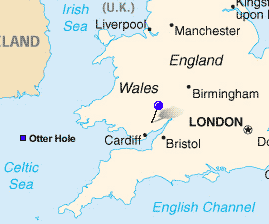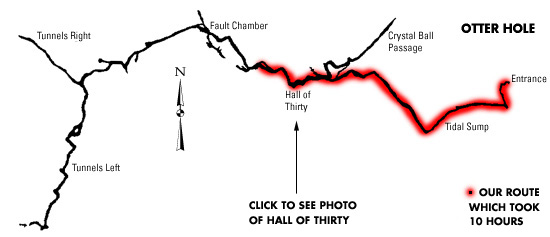 Caving
in Otter Hole
Caving
in Otter Hole
 Caving
in Otter Hole
Caving
in Otter HoleBack in September I came to Bristol on a short business trip for HP. Mathias had great plans for the weekend - Dave Grosvenor had been recruiting for a caving trip into Otter Hole and The Willerup Brothers were candidates for the small expedition. The group consisted of us, Dave, Tim Wilkinson and Sally Jubbs.
We had been caving before on our own and with others in the muddy caves in the Mendips south-west of Bristol. Otter Hole is located north of Bristol in South Wales by the banks of the river Wye. The cave is known as one of the most beautifully decorated caves in Britain so we were quite exited about the trip. Because of the delicate decorations inside visitors are required to descent with a guide from one of the local caving clubs.
Our guide was John Mole. His surname should guarantee some level of caving compentence, we thought, and we were right. He arrived in style on his old beat-up motorbike while we were putting on our gear in the parking lot near the cave. Quite a character, Mr. Mole. Wild dark hair, a weathered face with a disshevelled beard, and a skinny body with large, strong hands that showed that he was used to hard work. He immediately started rolling up a cigarette - a ritual we would witness countless times inside the cave.
We walked down to the cave entrance by the river where Mole gave us a briefing on the trip. The entrance of Otter Hole has an exiting feature. The river Wye is tidal so the entrance is only open an hour or two during low tide. When the water comes in the entrance (and exit!) closes for about 10 hours which means that once we enter we are comitted for the whole day. This can be serious in case we have an accident inside - one of the reasons the cave is grade 5 making it one of the most difficult caves in the UK. During our breefing, Mole mentions that we are required to clean formations inside the cave as a way of "paying" for the visit.
The entrance is closed by a small metal door and is just large enough for one person to squeeze through.
The entrance is closed by a small metal door and is just large enough for one person to squeeze through. The first section of the cave - until the tidal section or the sump - is very tight with lots of crawling and squeezing which is not for the claustrofobic. Mole led the way through the maze which otherwise would have been very easy to get lost in. It was a fairly tough crawl: it took between one and two hours to reach the sump and there was not a single place where you could stand up on the way. As we got closer to the sump the cave got increasingly muddy and when we could finally stand up near the sump we are all completely soaked in cold mud.
We spend more time than expected in the first section but the sump is still low and we can walk through in two feet of water. We duck the narrow "doorway" which about an hour later will be completely under water - and we will be on the other side of it. An interesting feeling. The next section is easier - the cave is much bigger here and we can stand up most of the way. It is still very muddy and wet. There are some formations here and there but the ones that make the cave famous are two hours further inside.
As the guide book describes:
"...Beyond the sump, a climb up a mud bank on the right and down into a muddy passage leads to an iron ladder. Climb up the ladder and continue in an upstream direction (behind you as you come up the ladder). After about 10 m a climb up through boulders on the left leads to a small chamber where there is a food dump (this is intended for real emergency use and not for parties who have just missed the tide). On the other side of the chamber is a squeeze followed by a drop.
Traverse around this on the left and climb down through boulders to a stream. A short section of stream passage is then followed to a boulder pile. Climb this and then traverse above the stream to a boulder floored chamber, beyond which is a pleasant section of streamway. Towards the end, a climb up through boulders on the right leads to a bedding chamber marked by a chain. Turn left into another chamber, on the other side of which is Choke 2. The choke is unstable and care must be taken. A route through the choke leads to a squeeze up into a chamber with a boulder slope. At the top of the boulders a fixed electron ladder leads back to the stream.
Almost immediately after the ladder pitch into the stream a rift passage at eye level on the right leads up to The Extension. Follow the rift upwards to the bottom of a boulder choke. A tortuous climb up through the choke leads to a small rift. Immediately behind ones head is a tricky climb up over a stal encrusted boulder into a L-shaped chamber. Turning left into the bottom of the L, a climb up boulders leads to a hole going down behind a boulder. Drop through the hole and cross a small chamber then climb back up again to the easiest one. The bedding chamber is the start of the Extension and from here the cave changes character completely. On the right, a tube leads via a climb and a squeeze down thorugh very loose boulders to Crystal Balls Passage with its fine pom-pom formations.
Straight across the bedding chamber, a taped path leads past increasingly magnificent formations to a large boulder floored chamber with enormous curtains in the roof. Crossing the chamber on the left leads to the Hall of Thirty with its large and magnificent stalagmite bosses..."
(...)
© The Willerups 1996-1998 |